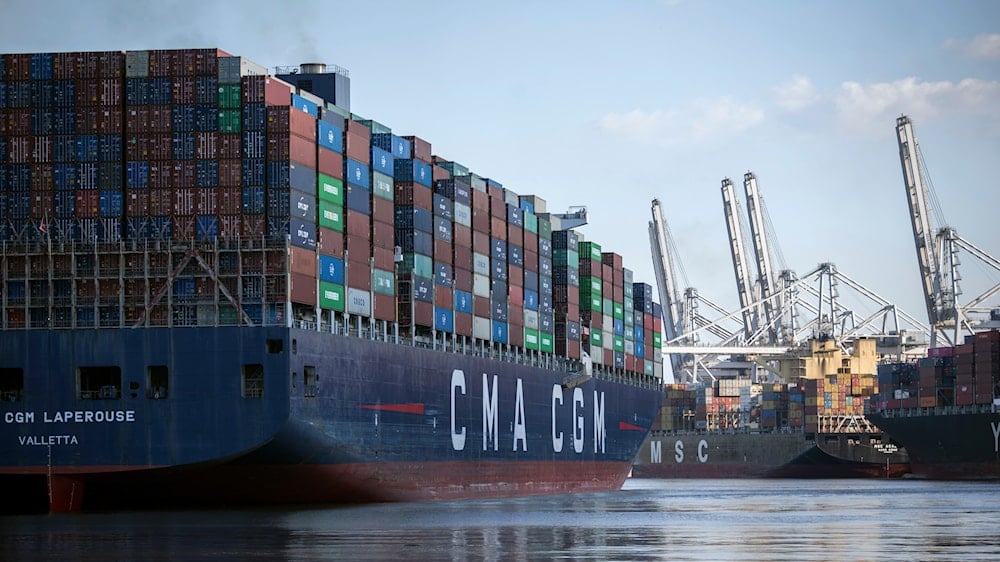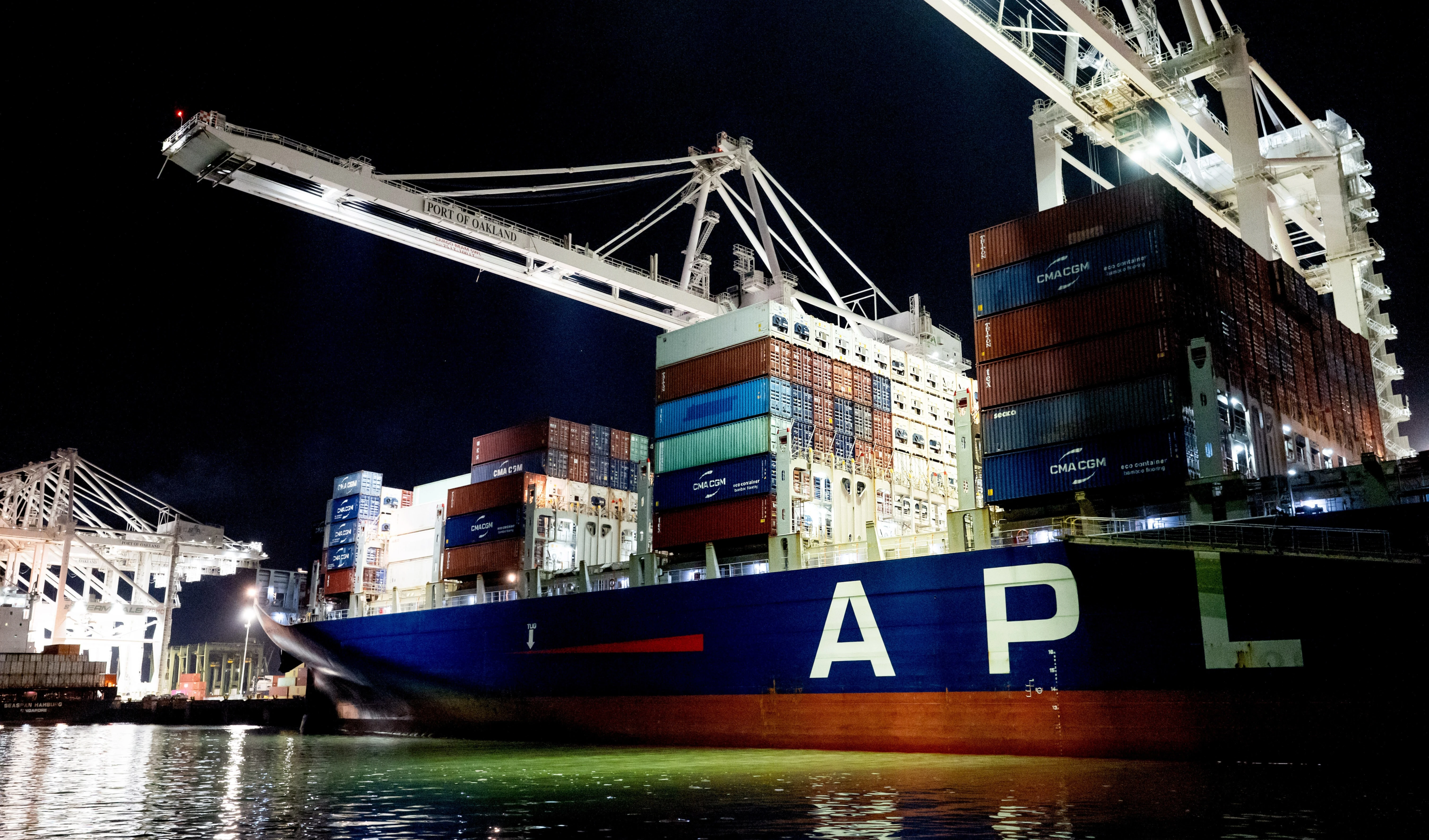US shipbuilding woes deepen as tariffs, outdated policies backfire
The US shipbuilding industry faces deep challenges as China dominates globally and Trump pushes tariffs on Chinese-built ships without fully understanding global shipping.
-

The container ship CMA CGM Laperouse, left, docks at the Georgia Ports Authority's Port of Savannah, Sept. 29, 2021, in Savannah, Ga (AP)
In 2019, the Kaimana Hila, the largest container ship ever built in the United States, was completed in Philadelphia with a capacity of 3,220 twenty-foot containers, but the largest container ships currently in operation, constructed by Yangzijiang Shipbuilding near Shanghai, can carry 24,346 containers, placing them in a completely different league.
According to Bloomberg, this stark contrast highlights the flawed reasoning behind the Trump administration’s push to counter China’s dominance in the maritime sector, as the White House prepares to impose tariffs starting October 14 on imports arriving via Chinese-owned or Chinese-built ships, a move that misjudged the complexities of global shipping.
The administration argues that these measures will safeguard US jobs, revitalize American shipyards, and address national security concerns while generating revenue that could support a Maritime Action Plan aimed at rebuilding and strengthening domestic maritime industries.
Bloomberg highlighted that the proposals risk placing undue pressure on US exporters and manufacturers dependent on imported materials while failing to meaningfully bolster the maritime industrial base, suggesting that a more effective maritime strategy would focus on global engagement rather than protectionist measures.
Subsidies or failed domestic policies?
Worries about shipbuilding in the US aren’t new; months before Trump’s return, five unions urged the Biden administration in March 2024 to impose fees on Chinese-built ships, arguing that China’s push to control global shipbuilding and logistics has eroded America’s maritime industry.
The petition led to an investigation by the United States Trade Representative that resulted in a comprehensive report released during Biden's final days in office, detailing China's substantial subsidies and support for its maritime industries, findings that Trump has unexpectedly adopted despite his usual rejection of Biden's policies.
The USTR report notably ignored the unions' assertion that China damaged US maritime firms, likely because the claim lacks merit as the shipbuilding decline in the United States stems from decades of domestic policies that shielded the industry from global competition, not Chinese subsidies.
Government subsidies have influenced commercial shipbuilding for decades, predating China's involvement, with the US historically being one of the largest providers of such support.
The curious case of US shipbuilding
The Emergency Fleet Corporation, a federal entity created to bolster the US merchant marine during World War I, allocated $3.5 billion for building 2,318 commercial ships in American shipyards, with the majority of this construction occurring after the war's conclusion in 1918.
Following the dissolution of that agency in 1936, Congress implemented the construction differential subsidy program as an alternative approach, providing over 50% funding for ships built by US companies engaged in international trade during the post-World War II era.
In the 1950s-60s, European and Japanese shipyards dominated global trade through subsidies and innovation, sparking an OECD effort to reduce market distortions. However, these measures failed to curb subsidies entirely, particularly as South Korea aggressively entered the market in the 1970s with state-backed industrialization plans.
By 1990, Korea’s shipbuilding output had surged eightfold since 1975, devastating competitors’ workforces. The subsidy wars continued, demonstrating how government intervention persistently reshaped the industry despite international attempts to enforce fair competition.
What was the US doing at that time?
The US has periodically supported its shipbuilding industry through subsidies while consistently avoiding policies that would promote international competitiveness, as exemplified by the 1920 Jones Act that reserves all domestic maritime transport for US-built and US-owned vessels, effectively restricting domestic shipbuilders to a protected but limited market.
The elimination of construction subsidies for US-flag carriers in 1981 under the Reagan administration led to nearly all merchant vessels built in the US over the past four decades being exclusively used for domestic trade.
US shipbuilding gets into a pickle
Bloomberg stated that the protectionist nature of these policies shields the limited number of remaining US merchant shipbuilders from competitive pressures to reduce costs or improve efficiency, resulting in domestically constructed vessels typically costing multiple times more than comparable foreign-built ships.
US shipyards' low annual output blocks economies of scale, forcing reliance on inefficient methods while foreign rivals profit from bulk orders. A 2002 study found US builders require far more labor hours than global competitors, with no signs of improvement, with Washington's meager $43 million in 2024 ship exports underscoring this decades-old disadvantage.
The elimination of construction subsidies led even US-owned international shipping companies to avoid American-built vessels, causing US shipyards to miss out on the massive late-1980s global trade expansion that drove unprecedented demand for container ships and vehicle carriers.
Policies hinder construction of commercial cargo ships
US shipyards demonstrate competence in constructing smaller vessels while struggling with commercial cargo ships due to policies that, though intended to preserve maritime security and a skilled workforce, have instead created an uncompetitive industry because of their fundamental disconnect from market realities.
From an economic standpoint, this shortcoming carries minimal significance as the United States faces no disadvantage when importing goods transported on foreign-built vessels or acquiring overseas-manufactured port equipment, provided market competition persists among suppliers, rendering self-sufficiency an impractical approach.
However, Bloomberg highlighted that the lack of international competitiveness in US commercial shipbuilding directly impacts national defense capabilities, as many Navy and Coast Guard vessels rely on the same yards that produce merchant ships, where aging infrastructure and a shrinking skilled workforce constrain the ability to rapidly scale military ship production when needed.
What can the US do?
Bloomberg notes that although revitalizing this declining industry isn't impossible, the necessary policy changes face steep political opposition, particularly those contradicting the Trump administration's parallel efforts to shield the US steel industry from competition.
US shipbuilders pay over double the global steel price due to protective tariffs, with Trump's 50% import levy exacerbating the cost disadvantage. These inflated material costs render American vessels, containers, and cranes uncompetitive internationally, creating an impossible conflict between protecting steelmakers and reviving maritime industries.
Even Jones Act-compliant vessels typically incorporate imported components like engines and propellers that become prohibitively expensive due to US tariffs, compounding the competitive disadvantages already facing American shipyards that struggle to produce large ships with full domestic content under any circumstances.
Finances; another hurdle
Financing new ships presents a major barrier given their $150+ million price tags, as buyers typically rely on government-backed loans secured against vessel mortgages or future revenue support that significantly reduces acquisition costs but exposes taxpayers to risk if trade downturns or oversupply devalue ships. According to Bloomberg, this means US-built vessels remain uncompetitive without similar federal loan guarantees to match foreign subsidies.
Without eliminating steel tariffs and offering competitive ship financing, US yards will remain confined to the protected domestic market, potentially improving only in naval construction due to steady defense budgets, as even potential mandates for LNG or vehicle carriers would generate too few orders to force meaningful productivity gains against foreign competitors.
Reviving a globally competitive US maritime industry would demand sustained subsidies tied to export mandates and domestic competition, requiring shipbuilders to modernize beyond outdated production methods and develop specialized technologies rather than relying on perpetual protectionism for obsolete products, according to Bloomberg.

 7 Min Read
7 Min Read










